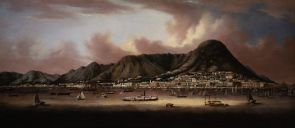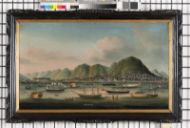The Harbor View
Together with Macao and Guangzhou, Hong Kong was an important trading hub from the sixteenth century to the mid-1800s [cf]. Views of the harbors of these three cities are a very popular subject in local eighteenth- and nineteenth-century painting studios. A view of Hong Kong harbor dated 1855-60, which closely resembles the one on our shell, has survived in the collections of the Peabody Essex Museum in Salem, Massachusetts [cf]. It was painted in oil on canvas by Sunqua, a painter active between the 1830s and the 1870s in the Pearl River delta area. The Peabody Essex Museum holds one of the largest collections of Chinese art made for export worldwide. Paintings of harbor views as well as other motifs made in workshops in the Guangzhou area have survived also in other collections worldwide, for example in the Netherlands [cf].
Victoria Harbor was named after Queen Victoria (1819-1901) when Hong Kong was under British rulership. Since the city’s handover to China in1997, Hong Kong has become a politically contested space. The territories surrounding Victoria Harbor, particularly Victoria Park, have become one of the major sites of Hong Kong citizens’ protest against the government where rallies on every anniversary of the Tiananmen massacre of 1989 take place as well as other political gatherings [cf]
The highest point of the depicted mountain chain on Hong Kong island, Victoria Peak, is nowadays surrounded by skyscrapers that have become iconic markers of the city. While the houses we see on the shell are a mix of local and colonial-style buildings, today’s towers have been designed by famous architects including the Guangzhou-born American I.M. Pei (1942-2014) [cf].

